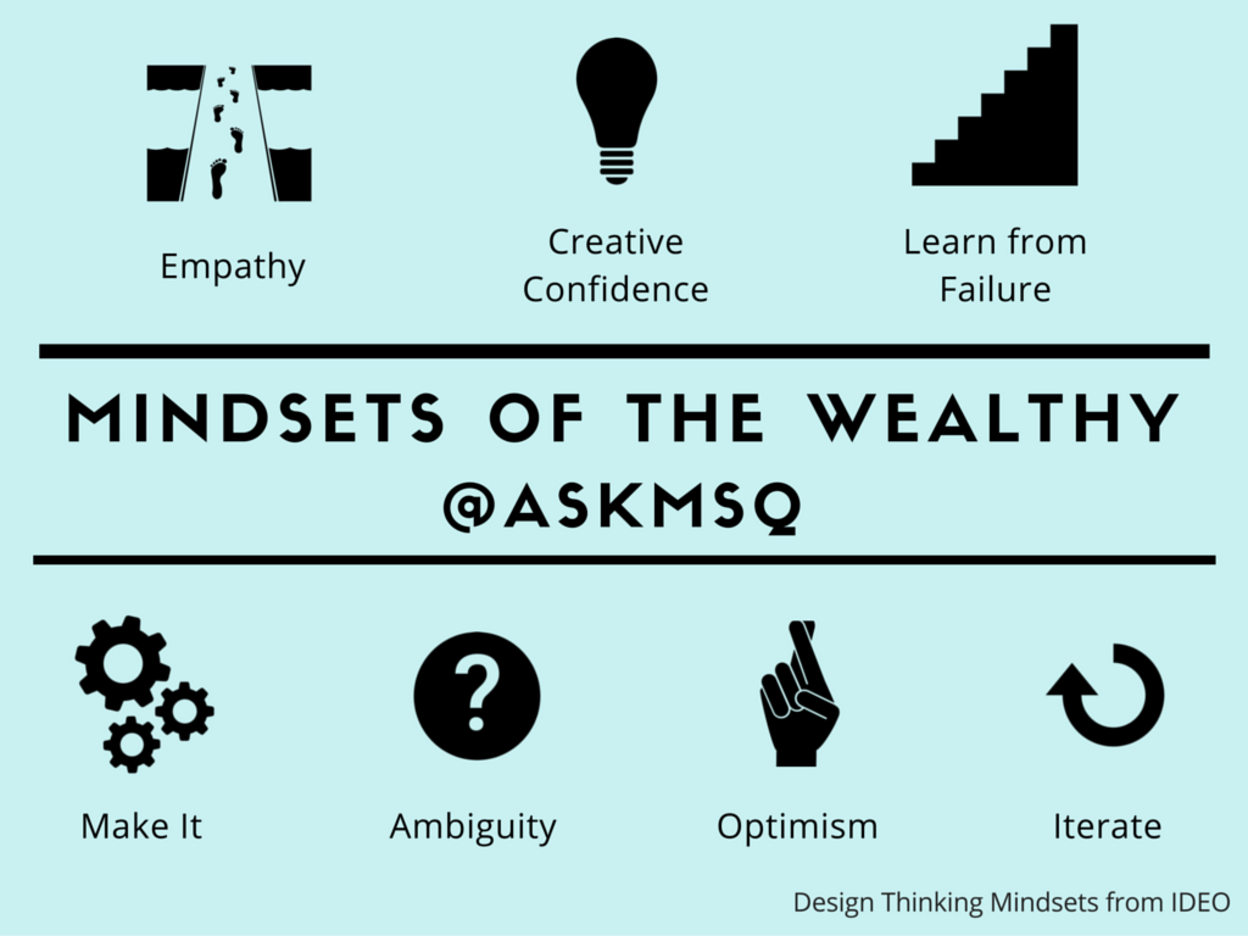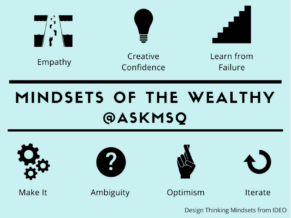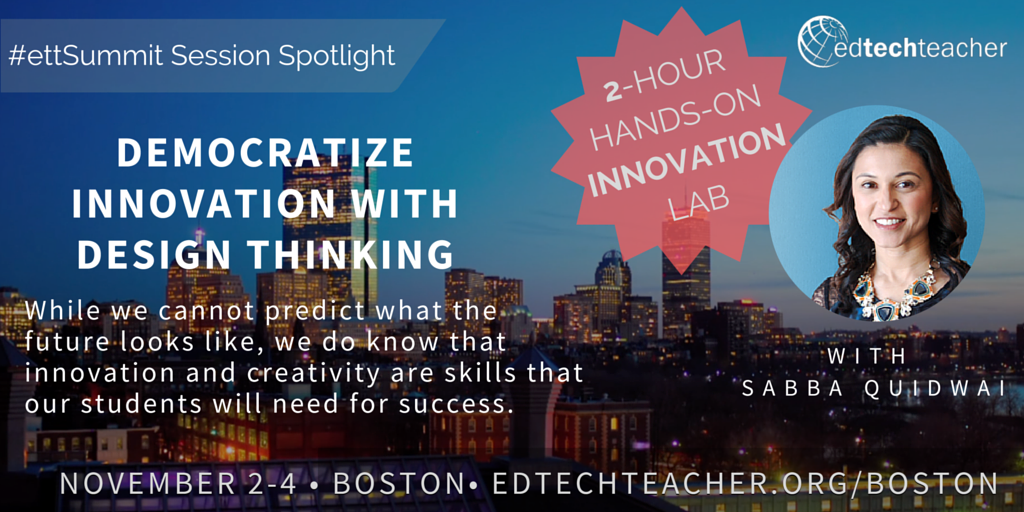This post from Sabba Quidwai first appeared on EdTech Researcher.

We live in a world today where knowledge is a commodity. Instead of focusing on mastering content, we need to focus on mastering skills and developing mindsets such as creative confidence, empathy and failing forward, to name just a few.
In an article previewing his new book, "The Choose Yourself Guide to Wealth," James Altucher talks about the death of the salaried employee and offers strategies for success in today's new economy. He makes a bold and perhaps even controversial statement, "Wealthy people own valuable assets. The middle class and poor simply rely on salaries."
While Altucher is focused on wealth in a monetary sense, his statement reminds me of a point that I often make to graduate students in the Physician Assistant program at the University of Southern California. Having grown up and experienced school for over 20 years in a traditional format, many struggle to understand how developing these mindsets relate to medical school. Students at this age have had little experience with the changing world of work, and the conversations always come back to how these skills are an investment in their future, not just one year after they graduate but for many years to come. Those who are more future-oriented appreciate developing these skills; and those who focus more on the now, demand more "sit and get" lecture.
In reflecting on Altucher's statement, I began to realize that in education, the wealthy of the future will be comprised of those future-oriented students who invest in the valuable assets of mastering skills and mindsets. Meanwhile, the middle class and poor will be those who do not invest in those assets when they have the opportunity - if one was even provided to them. The importance of creating a group of students who will be "wealthy" is not only important for the strength of our economy, but it is necessary for the sustainability of our planet.
When we look around us, we often see "others" such as Richard Branson, Elon Musk, and Steve Jobs as those who have the skills and mindsets to change the world. We rarely see ourselves. In Outliers, Malcolm Gladwell says that what differentiates this mindset is a great mentor. There are very few who have the privilege of shaping the next generation. And yet, educators are one of the few groups who work with students day in and day out empowering them and serving as mentors who can nurture mindsets that will serve as assets in a student's future.
How then can we begin? As the challenges and opportunities facing education grow more complex, design thinking is one framework that we can begin to apply to our curriculum in order to nurture a collection of mindsets. Identified by Design Kit at IDEO, design thinking allows us to gain insight and yield innovative solutions for any type of challenge that we face by developing key mindsets.
Mindset #1: Empathy
Emi Kolawole, Editor-in-Residence at theStanford University d.school says, "I can't come up with any new ideas if all I do is exist in my own life."
What differentiates design thinking from other frameworks is that it asks users to start with developing empathy. When trying to address challenges, we often jump to the solution - imposing our own opinions and ideas upon others and ultimately arriving at solutions that are not sustainable. By beginning with empathy, "what we think" is challenged by "what we learn."
Mindset #2: Creative Confidence
David Kelley, founder of IDEO, says, "Creative confidence is the notion that you have big ideas, and that you have the ability to act on them."
Oftentimes, when we see a new app be released or hear an idea, we react with, "I could have thought of that," and it's probably true! The question then becomes what differentiates the person who has the idea with the person who executes that idea. The answer: creative confidence.
Creative confidence is not about being a great artist or graphic designer, it's about believing that you have ideas that can bring about a positive change and that you have the skills to see your idea through.
Mindset #3: Learn from Failure
Tim Brown, CEO of IDEO says, "Don't think of it as failure, think of it as designing experiments through which you're going to learn."
The struggle is real and ultimately profitable. When we come face-to-face with problems, we often spend hours and hours, days upon days, crafting the perfect solution only to come up empty-handed. Iteration is a key component of design thinking, where in the early stages quantity is greater than quality. By getting ideas out as rapidly as possible, we surprise our ourselves by what we are able to come up with.
Mindset #4: Make It
Krista Donaldson, CEO of d-Rev says, "You're taking risk out of the process by making something simple first. And you always learn lessons from it."
Makerspaces are popping up in schools across the country, providing students with the opportunity to imagine and build. For many, makerspaces may initially appear for those who are interested in 3D printing or robotics. However, as Krista says, human-centered designers have a bias towards action, they want to see things become real and see their ideas come to life. Using design thinking as an approach to how students interact with the makerspaces provides a powerful foundation for creating meaningful work.
Mindset #5: Ambiguity
Patrice Martin, Creative Director and Co-Lead at IDEO says, "We may not know what that answer is, but we know that we have to give ourselves permission to explore."
When students enter my design thinking in healthcare class on the first day, and we ask them to reflect on a health challenge that they would like to explore, they think of a solution along with the challenge. Learning to take that step back and start with a beginner's mind is key to creating sustainable solutions that will truly bring the impact you desire.
Mindset #6: Optimism
John Bielenberg, Founder of Future Partners says, "Optimism is the one thing that drives you forward."
It's easy to become overwhelmed by the number of challenges that face humanity today. From unemployment to climate change, there's lots of challenges that need creative solutions. Those who will not become overwhelmed are optimistic about the future, because like Margaret Mead said, "Never underestimate the power of a small group of committed people to change the world. In fact, it is the only thing that ever has."
Mindset #7: Iterate
Gaby Brink, Founder of Tomorrow Partners says, "What an iterative approach affords us is that we gain validation along the way...because we're hearing from the people we're actually designing for."
Knowing that we are not going to succeed on the first attempt is a far cry from what we are taught in school. The assignment once turned in, the exam once taken, and the comment you just shared in class must be right, otherwise you will be marked wrong. Developing an iterative mindset, after years of having been taught that you must be perfect on the first try, is a challenging task for many. By keeping our users in mind, ultimately we learn that through iteration we are not just creating solutions to share with others, but we are creating solutions that are sustainable for our intended people and communities.
These mindsets are the assets of the wealthy. The world needs more teacher leaders to emerge who can provide everyone with these assets. Teacher leaders who can use design thinking to break the traditional moulds of our educational system and allow everyone to become wealthy.
Learn more about Design Thinking with Sabba in Boston.


